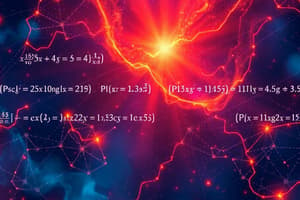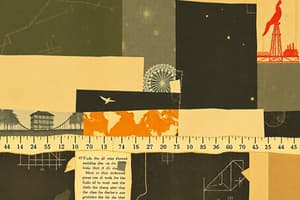Podcast
Questions and Answers
Which of the following statements is true?
Which of the following statements is true?
- All boundary points of a rational inequality that are found by determining the values for which the denominator is equal to zero should always be represented by plotting an open circle on a number line. (correct)
- All boundary points of a rational inequality should always be represented by plotting a closed circle on a number line.
- All boundary points of a rational inequality that are found by determining the values for which the numerator is equal to zero should always be represented by plotting an open circle on a number line.
- All boundary points of a rational inequality should always be represented by plotting an open circle on a number line.
In the definition of the exponential function f(x)=b^x, what are the stipulations for the base b?
In the definition of the exponential function f(x)=b^x, what are the stipulations for the base b?
- The base b must be greater than one.
- The base b must be greater than or equal to zero.
- The base b must be greater than zero but not equal to 1. (correct)
- The base b cannot be a fraction.
Which of the following statements is not true for the graph f(x)=b^x?
Which of the following statements is not true for the graph f(x)=b^x?
- x=y^b
- x=b^y
- y=x^b (correct)
- y=b^x
Which of the following is not true about the expression log7 49?
Which of the following is not true about the expression log7 49?
To what is the expression logb b^x equal?
To what is the expression logb b^x equal?
Which of the following statements is not true for the graph of y=logb x for b>1?
Which of the following statements is not true for the graph of y=logb x for b>1?
The domain of f(x)=logb[g(x)] can be determined by finding the solution to which inequality?
The domain of f(x)=logb[g(x)] can be determined by finding the solution to which inequality?
Which of the following statements is not a property of logarithms?
Which of the following statements is not a property of logarithms?
Which of the following is not true?
Which of the following is not true?
Which of the following is true?
Which of the following is true?
Why is the logarithmic property of equality, which says that 'if logb u=logb v, then u=v' true?
Why is the logarithmic property of equality, which says that 'if logb u=logb v, then u=v' true?
If a and b are positive real numbers such that a≠1, b≠1, and u is any positive real number, then the logarithmic expression logb u is equivalent to which of the following?
If a and b are positive real numbers such that a≠1, b≠1, and u is any positive real number, then the logarithmic expression logb u is equivalent to which of the following?
Logarithms are studied for which of the following reasons?
Logarithms are studied for which of the following reasons?
In solving the exponential equation 4^x=7^(x-1), which of the following is not true?
In solving the exponential equation 4^x=7^(x-1), which of the following is not true?
Flashcards are hidden until you start studying
Study Notes
Rational Inequalities
- Boundary points determined by the denominator set to zero should be represented with an open circle on a number line.
- Boundary points determined by the numerator set to zero may not necessarily represent an open circle.
Exponential Functions
- The base ( b ) of the exponential function ( f(x)=b^x ) must be greater than zero and not equal to one.
- As ( x ) approaches negative infinity, the graph of ( f(x)=b^x ) approaches zero.
Logarithmic Properties
- The expression ( \log_7 49 ) represents the power that 7 must be raised to in order to yield 49, hence it equals 2.
- The term ( \log_b b^x ) simplifies to ( x ) for ( b>0 ) and ( b \neq 1 ).
Graphs of Logarithmic Functions
- The graph of ( y=\log_b x ) passes through the point (1,0) and (b,1), with a vertical asymptote at ( x=0 ).
- For ( b>1 ), the graph of ( y=\log_b x ) is decreasing on the interval ( (0, \infty) ) is false; it actually increases.
Domain Restrictions
- The domain of ( f(x)=\log_b[g(x)] ) is determined by the inequality ( g(x)>0 ).
Properties of Logarithms
- Logarithmic identities include:
- ( \log_b \frac{u}{v} = \log_b u - \log_b v )
- ( \log_b u^r = r \log_b u )
- ( \log_b 1 = 0 )
- An important logarithmic identity, ( \ln e^8 = 8 ), must hold true.
Logarithmic Function Uniqueness
- The property that if ( \log_b u = \log_b v ), then ( u = v ) is valid due to the one-to-one nature of logarithmic functions.
Change of Base Formula
- The logarithmic expression ( \log_b u ) can be transformed using the change of base formula:
- ( \log_b u = \frac{\log_a u}{\log_a b} )
Use of Logarithms in Equations
- Logarithms simplify the solving of exponential equations when direct base comparisons are not viable, assisting in more complex calculations.
Solving Exponential Equations
- In the equation ( 4^x = 7^{(x - 1)} ), transforming it involves:
- ( x \ln 4 = (x - 1) \ln 7 )
- From this relation, if ( x\ln \frac{4}{7} = -\ln 7 ), it leads to the solution ( x = -0.2005 ).
Studying That Suits You
Use AI to generate personalized quizzes and flashcards to suit your learning preferences.




